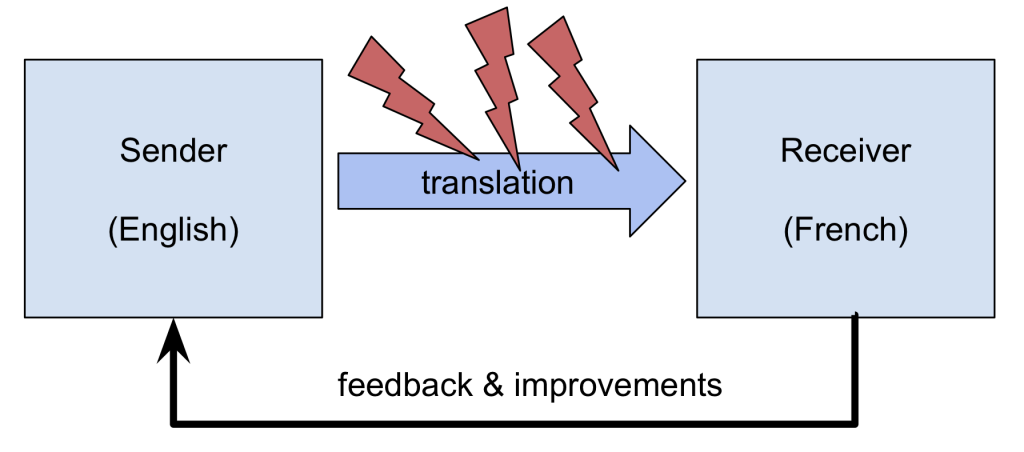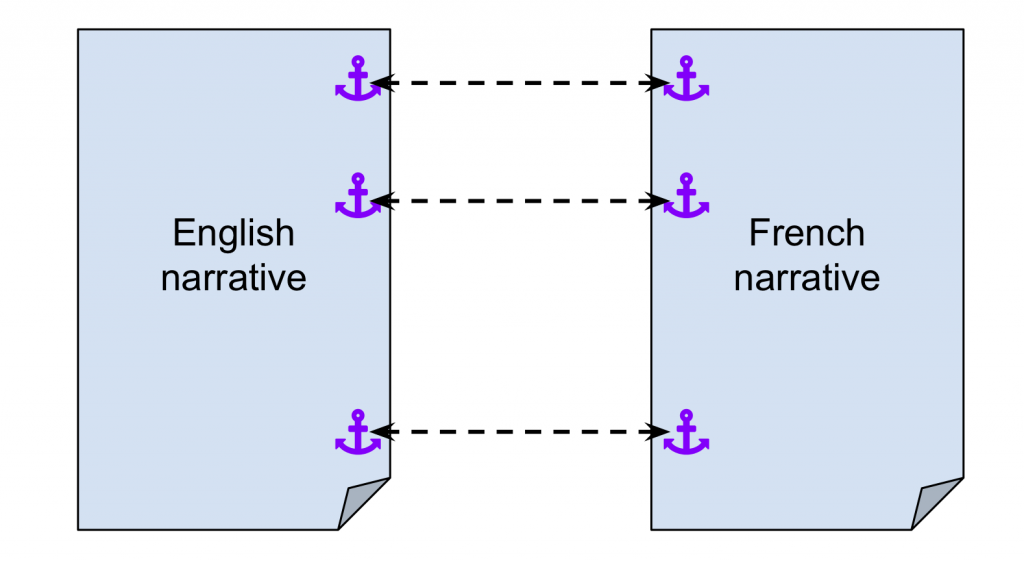I have been working on a French translation for the math book and in the process I stumbled upon some really powerful “authoring hacks” that I would like to describe here in case they might be useful for other bilingual authors and educators.
Let’s see les maths!
Before we begin with the “How it’s made” episode, let me show you some examples of the final product. I have selected the best four “backports” — explanations that now exist in the English version thanks to the additions in the French version.
- Reader feedback was consistent at pointing out the algebra sections as boring and TL;DR. Readers are willing to learn algebra (the rules for manipulating math expressions), but then when it comes to algebra “techniques” they are not sold on the concept. One solution to this problem would be to drop the “boring stuff” (lower the expectations of the reader), but I was having none of this. Instead I decided to just improve the explanations and add pictures: Completing the square en Français et in English.
- Functions (modelling superpowers) are the best thing ever, and probably the most powerful tool readers will develop in the book. This is why proper definitions and examples of functions are essential.
- Polar coordinates are super important—for both practical reasons and for the “aha” moment (knowledge buzz) that occur when readers understand $(x,y)$ is just one example of the many possible representations of the points in the Cartesian plane and $r\angle \theta$ is an equivalent representation (instructions that specify the position of a particular point int he Cartesian plane based on the distance $r$ and direction $\theta$).
- Speaking of knowledge buzz through representation theory, the book now finally has a proper motivation why readers need to think about the concept of a basis (a set of direction vectors that is used as the coordinate system for a vector space). On this one I go back to the basics—explain through an example.
Contuinuez à lire si ça a l’air intéressant. Read on if you’re interested.
Context
The No Bullshit Guide to Mathematics (a.k.a. the green book) is a short summary of all the essential topics from high school math intended for adult learners. Last year, by sheer luck and good fortune, I was introduced to Gerard Barbanson who offered to translate the book to French. Gerard is a professional mathematician, a native French speaker, and has also taught math in English for many years, which makes him the perfect translator. Gerard is leading the translation project and provides lots of useful feedback and improvements for the text.
Look out for a followup blog post and announcement about the release of the French translation (in a few months). This blog post is not about that, but about the benefits of the translation efforts brought to the original English version.
Translation as a way to highlight problems
While reviewing Gerard’s “first pass” of translation, I kept noticing spots where the explanations didn’t work well. My initial reaction was that this was a bug in the translation, but every time I looked into a passage, I realized the problem existed in the original English text, and the translation only magnified the problem and made it more noticeable. Examples of “weak spots” include paragraphs that are too conversational (i.e. no content), missing definitions, and explanations that are unclear or confusing.
I found this process to be extremely useful. Even though I’ve read and reread the English version many times, I never noticed these weak spots until now. The translation process highlighted the lack of clarity in certain specific parts and forced me to think of ways to fix these explanations. Essentially, if an explanation is good, it will “survive” the process of translation, but if it’s not 100% solid and clear, then it turns into “noise” at the end of the process.

We can think of translating explanations as a communication scenario, where the source language (English) is the transmitter, and the target language (French) is the receiver. The process of translation adds “noise” in the form of ambiguities, so the received signal is a degraded version of the original signal. The French translation will be good only if the original English explanation is really solid and clear. This puts additional pressure on the original English version to be extra clear and precise.
The language of mathematics
Another benefit that came out of the translation work has been the focus on the consistent use of terminology and notation. For the most part, mathematical concepts translate well between English and French, but sometimes French has more precise terminology available. For example I’ve adopted the precise terminology of source set and target set to refer to the sets that appear in the function “type signature,” which are distinct concepts from the function’s domain and image.
One of the core responsibilities of any math teacher is to use precise and consistent language to describe mathematics, including choosing the simplest terminology when the complicated terminology is unnecessary, but not shying away from the “real math” terms when they help illuminate the concepts. Working with Gerard to explicitly establish our conventions for the French version forced me to also be consistent in the English version as well.

I guess that’s not too surprising—using consistent terminology and notation is just best practices.
Bilingual writing for better explanations
Perhaps the most surprising thing I noticed from the translation project is the amazing efficiency of developing English and French explanations in parallel, sometimes aided by Google Translate. This was most apparent in writing the new sections on polar coordinates and vectors. Normally writing a new section would take me days, going through several mediocre versions, rereading on paper, and slowly converging to a decent narrative. I noticed the new sections I added over the holidays converged to a “quality product” much faster. Here is the process I followed:
- Explain the concept in English.
- Translate explanation to French improving and simplifying it in the process.
- Take the best parts of the French explanation and incorporate them back into the English version. Go to step 2.

After a few cycles of going between the English and French version, I saw clear improvements from the initial English version and of course the French version was improving in tandem.
Kaizen for textbooks
I guess the thing that makes me excited about these “authoring hacks” is the fact that they allow me to go one step deeper in the process of continuous improvement of the books. I’ve read and reread the text at least a dozen times, worked closely with my editor Sandy Gordon to iron out all the major flaws and acted on feedback from readers to fix confusing passages, but at some point I get tired and start to let things go. I say to myself things like “yeah this is not the clearest explanation, but it’s kind of OK as is.” This is partially out of laziness, but also because of the law of diminishing returns: sometimes rewriting makes things worse!
There is a famous quote that says:
“There is no great writing, only great rewriting.”
― Louis D. Brandeis
I know this is good advice, but it’s hard to adhere to it. After five editions of the math book, I find it difficult to motivate myself to rewrite things, even if I know there is still room for improvement. That’s why I’m always looking for hacks that can help with the process (see for example the text-to-speech proofreading hack). The translation work of the past few months gave me the impetus to do more productive rewriting without it feeling like a chore. Look out for the updated No Bullshit Guide to Mathematics v5.4 coming soon in both English and French. Sign up for the mailing list if you want to be notified.
Elias
February 19, 2020 — 3:39 pm
Oh wow, that’s an awesome finding!
And it makes a lot of sense!
I have a friend who works as an interpreter, she finished recently her PhD and her thesis was on a method to evaluate a hypothesis about these ambiguities and nuances that translations expose in literary narratives (euh, I think it’s more complicated than that, but that’s what I got at least, haha).
I find very appealing this idea of using translation precisely to find ambiguities more quickly in a text that aims for clarity!
Rock on! ^^